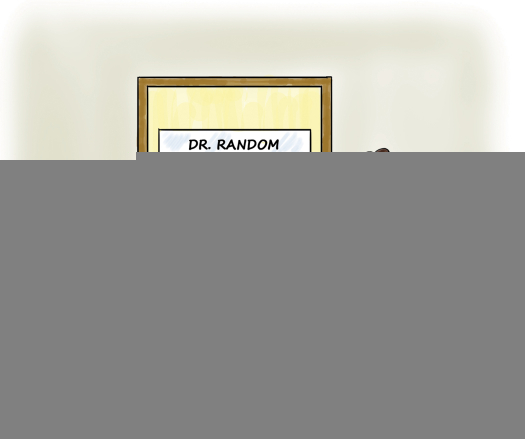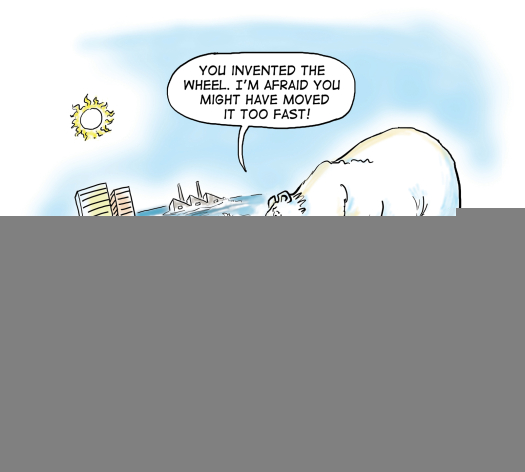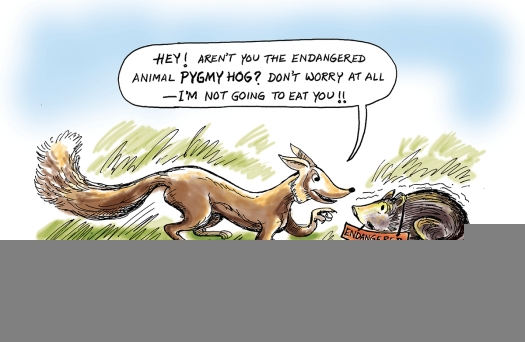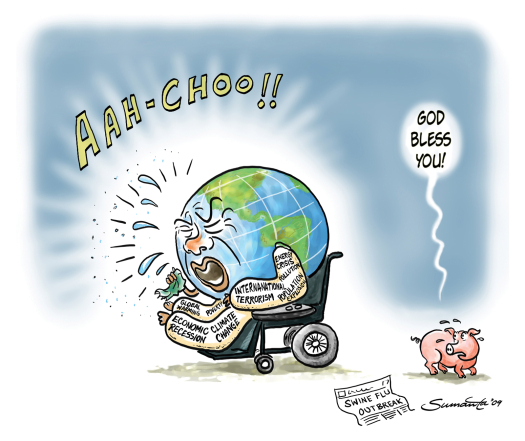The Scientific Cartoonist
August 1, 2010I happened to come across Sumanta Baruah’s name during a chance conversation with a friend of mine. When I visited Baruah’s website cartooncosmos.com, I simply knew I had to know more about him, and what goes through the brilliant mind which comes up with amazingly witty and at the same time thought-provoking cartoons. Possibly the first and only Assamese till date to have earned nationwide fame as a cartoonist, Sumanta Baruah specializes in cartoons on science, environment and global warming, politics and society. As it turned out a couple of days later while we chatted over the telephone, he is also wonderfully accommodating and easy to talk to, which I found out first hand.

They say some people are just “born with it”, and even Sumanta Baruah was attuned towards scribbling and sketching from an early age, which was fueled by perusal of comic books. Any quintessential Indian would identify with the pre-teen fascination towards the Tinkle and the Amar Chitra Katha comic books, and Baruah was no exception, with the only difference being that while other children limited themselves to reading the comics, Baruah would try to replicate the cartoon characters in those comic books, and even at that tender age, come up with cartoons of his own, and make stories out of his drawings. This spark of creativity was noticed by Baruah’s father, Shree Kshiradhar Baruah, who retired as the Head of the Department of Chemistry in Biswanath College, and is a renowned writer himself. Sumanta Baruah’s father encouraged him in this passion, and while writing an article for a magazine called “Drishti” (edited and published by Dr. Dinesh Chandra Goswami, on behalf of the Govt. of Assam), he asked his son, who was then all of ten, to come up with a cartoon on fire to accompany the article. The first published cartoon only paved the way for more, if anything. In the ensuing years, Sumanta Baruah’s cartoons got published in many more magazines, noteworthy being Science Reporter, Resonance, Journal of Assam Science Society, Drishti and Prantik. Baruah was a regular contributor to the magazine” Vigyan Jeuti” from 1993 to 2001. The magazine, which was published once in every two months, carried two of Baruah’s cartoons on each issue. Currently, Baruah’s cartoons get published in the magazine “Satsori” on a regular basis.

The most interesting thing I had found was that Sumanta Baruah had no formal training in drawing, but as it turned out, it is more the norm, with the most renowned cartoonists being the ones who never had any sort of professional guidance in drawing. And that, Baruah says, is what is atypical of cartoons, compared with other forms of drawing. While in paintings, emphasis is solely on the drawing, in cartoons it is often more about the quips accompanying the cartoons, ergo lessening the focus on the perfection of the sketch. Baruah goes so far as to say that formal training would prove to be a limitation, since it is preferable to let one’s own creativity and imagination take over, rather than let convention and rigid techniques affect one’s style. As in the case of Baruah himself, he had studied the works of other cartoonists, like the famous R.K. Laxman, while his father would continuously provide him with guiding materials like flip books, and the Span magazine published by the American Embassy.

Although a picture says a thousand words, a cartoon, I would say, says it all with just a few strokes and fewer words. I had really wanted to know what went into creating cartoons, since I was baffled by how anyone could come up with just the right words to go with the right sketches, which combined together led to a cartoon that made one stop, and think, and giggle. Baruah then admitted that initially, it was difficult to come up with ideas. He would use his awareness on the current issues, news he had picked up from journals and papers, about the latest scientific developments or what was in general going on in the society. The humor element, he says, had been imbibed in him from nothing but all the funny stories in the Tinkle magazine. While ideas come to him lot easier now than they did before and his drawing has definitely improved since then, Baruah does rue the fact that as a child he had been much more open to unusual and bizarre ideas, something that had back then helped him to create some of his favorite cartoons. Maybe it had to do with the way he had perceived things as a child, coupled with a wild imagination, but Baruah himself wonders now how he could have created those cartoons then.

In 2003, while pursuing his Masters in Computer Applications from Tezpur University, Sumanta Baruah’s compilation of cartoons got published in the form of a book called “Science Shapes Life”, by the Assam chapter of Indian Science Writers’ Association, and in 2006, Baruah’s cartoons got selected to be exhibited in two international cartoon festivals; the 3rd Rhodes International Cartoon Exhibition held in Greece, and the International Cartoon Festival held in Iran. Sumanta Baruah was one of the fifteen Indians, and the only Assamese whose cartoons were selected for the latter. Just recently, Sumanta Baruah had his first solo science cartoon exhibition aptly named “Smile with Science” which was held at the Indian Cartoon Gallery, Bangalore and organized by Indian Institute of Cartoonists in Bangalore, from 27th May to 12th June, 2010, making him the first Indian science cartoonist to have achieved this feat.

While it takes a highly inventive and ingenious mind to find the humor hidden in science, Sumanta’s Baruah’s cartoons come across as a refreshingly novel insight into what people would normally call the drab domain of science. With Baruah’s cartoons being published in the most prestigious names in the field of science journals, one can expect even higher achievements from this impressive person, who is now currently working as an engineer in Samsung and is based in Bangalore. Of late ‘Current Science’, considered as the most prestigious science journal of India has started publishing Baruah’s cartoons regularly. He has also been asked to create cartoons on Mathematics, for the special issue of the journal to be published for the upcoming International Congress of Mathematicians going to be held for the first time in India in August this year.

Wondering where Sumanta Baruah sees himself as a cartoonist in the future, I asked him about his plans. He is nurturing a dream of taking up cartooning as a full-time profession someday so as to give full attention to this passion of his. Anyone going through Baruah’s cartoons on global warming and environment awareness would appreciate the impression they make on one’s mind through humor underlying the subtle warning implied by those cartoons. With the whole world waking up to the current situation which is bound to have dire consequences, we wish Baruah’s innovative cartoons would continue to illuminate us, and make us think. We at Fried Eye wish Sumanta Baruah a creatively fruitful journey into the fascinating and imaginative world of cartoons.
We welcome your comments at letters@friedeye.com

[…] This post was mentioned on Twitter by Fried Eye, Fried Eye. Fried Eye said: The Scientific Cartoonist http://goo.gl/fb/u9SAI #coverstory #friedeyespecial #issue15 #issues #voli […]